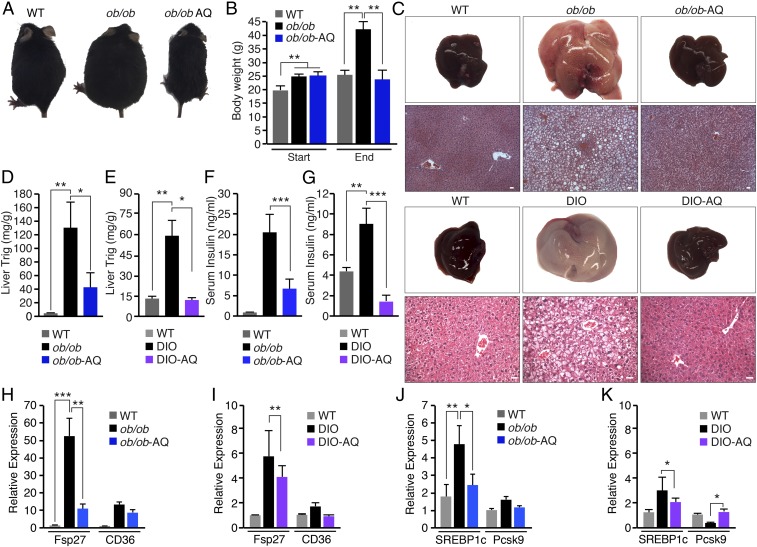Fig. 6.
NURR1 agonist reverts hepatic steatosis in obese mouse models. (A) WT and ob/ob mice on normal chow. ob/ob mice were administered AQ (ob/ob AQ) in drinking water from 5 to 9 wk of age. (B) Body weight of WT, ob/ob, and ob/ob mice administered AQ (ob/ob-AQ) at the start (5 wk of age) and the end (9 wk of age) of the experiment. (C) Livers showed that AQ treatment for 4 wk reverts hepatic steatosis in ob/ob and DIO mice to normal WT levels. (C, Lower) H&E staining. (Scale bars, 50 μm.) (D and E) Quantification of liver Trig levels of WT, ob/ob, and ob/ob-AQ mice after 4 wk of AQ treatment (D) and WT, DIO, and DIO-AQ mice after 4 wk of AQ treatment (E). (F and G) Serum insulin levels of WT, ob/ob, and ob/ob-AQ mice after 4 wk of treatment (F) and WT, DIO, and DIO-AQ mice after 4 wk of treatment (G). (H and I) Expression of genes involved in fatty acid synthesis fat-specific protein 27 and transport (CD36/FATP) in liver tissue of WT, ob/ob, and ob/ob-AQ after 4 wk of treatment (H) and WT, DIO, and DIO-AQ after 4 wk of treatment (I), as measured by real-time qRT-PCR. (J and K) Expression of genes involved in liver lipid metabolism, SREBP1c and Pcsk9, in liver tissue of WT and ob/ob mice in the absence or presence of AQ after 4 wk (J) and WT and DIO mice in the absence or presence of AQ after 4 wk (K), as measured by real-time qRT-PCR. Data are represented as mean ± SEM. n = 6. *P < 0.05, **P < 0.005, ***P < 0.0005.

